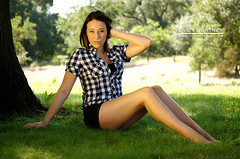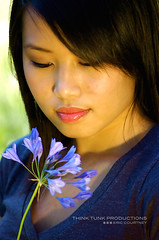Test shooting in portrait photography is interpreted many different ways in regards to a model test shoot. After doing a little browsing around on the subject I see that there is still information online that is quite dated and doesn't really apply anymore with the evolution of digital photography. I am going to share my philosophy behind test shooting and how models and photographers can benefit.
What is a test shoot? Simply put, a test shoot for the photographer is a means to get acquainted with future talent and/or test photography equipment. For a model it is to start or generate a quality model portfolio quickly on a budget and introduce themselves to the industry. Although it is not uncommon for experienced models to participate in a test shoot, that is basically it in a nutshell.

Test shoots are almost always done on a trade agreement; an investment of time straight across for both photographer and model. As payment for the models time, the photographer typically provides the model with copies of the photos that were taken during the shoot. As payment for the photographer, a photog gets a beautiful subject to work with, the opportunity to work with a potential long term client, as well as knowledge to improve skills and portfolio. TFP and TFCD are popular acronyms that go along with test shooting in the photographers models world. TFP stands for Trade/Time for Prints (printed photos of the shoot), and TFCD stands for Trade/Time for Compact Disc (CD or DVD that contain photos from the shoot). While these types agreements often go beyond test shooting, when a Test shoot is offered or suggested, trade should always be considered by both parties. But don't take it personally if you are turned down.
Photographers Model - As a photographer, when I do a test shoot with a model, it is usually to figure out a couple of things. The first thing I want to figure out is how much experience he/she has in front of the camera. If the model is relatively inexperienced, and could use a lot of improvement in their modeling skills, as well as taking direction from a photographer effectively, it doesn't make sense to invest time and money into a large setup that requires all the elements for a nice shoot. Those elements could be a nice location, hair and makeup, and wardrobe to name a few. Taking the time and money to set all that up while running the risk of getting mediocre results at the very best can be avoided by doing a test shoot before hand.
The other thing I like to figure out is how to improve my own technique when working with models. Trying something new and different, or trying to improve on something that didn't turn out as well on a previous shoot. That can include
posing, angles, camera settings, and most importantly... Communication. Communication is paramount.
Of course another good reason for a test shoot is new equipment. If you have a new camera or flash gun, and you want to put it to good use right away, scheduling a test shoot is very effective to understand the different nuances that come with new equipment.
 Models Photographer
Models Photographer - Test shooting for new, young, and/or up and coming models is a great way to build a portfolio fast on a minimal budget. A great way to get quality images for their portfolio quickly is to introduce themselves to reputable photographers who produce high quality images. Nowadays a good place to achieve this goal is to browse modeling photographer networks online where you can view photographer profiles and portfolios. Models should be prepared to provide images upon introduction.
One very popular network in the industry is
Model Mayhem. As a model you can sign up for an account as long as he or she meets the minimum
requirements.
A model shouldn't be surprised to find a good number of inquiries from photographers to set up a shoot over a few simple introductions. In some cases, it's quite possible a new model could be booked right into a major commercial shoot right out of the gate without any mention of a test shoot. Not everyone will experience such fortunate timing, but it happens.
If a model really likes a photographer's portfolio, it never hurts to express appreciation in an effort to fuel the incentive to work with him or her (insert small photographer chuckle here). It's quite possible you will generate some long lasting successful business relationships from just a simple test shoot.
Regardless of what type of shoot, models should be up front with the photographer, and vice versa. Inform them of personal boundaries and expectations, if needed, to avoid anything that might make the shooting scenario uncomfortable. Having a fun test shoot means optimal results as well as a promising business relationship.
The Details:The details of the shoot should always be arranged up front as to the type of the agreement and what both parties will get out of the shoot. Even though it is a test shoot, models should be prepared to sign a model release. Photographers should also provide clear instruction on how, and how long, copies of the images will be distributed to the model(s). Test shooting is typically a 1-2 hour shoot, although I have heard from models that they can go on much longer. It's probably a good idea, for both parties, to have an idea of the time frame before the shoot actually takes place.
I hope you find this information useful. Please link to it if you do. Check this out:
Photography Posing SecretsSacramento PhotographyRecent Articles:
5 Easy Tips to Improve Portraits of ChildrenCamera Shy Subjects - The Art of Dealing with Photo Portrait NightmaresPost Processing for Portrait Photography



